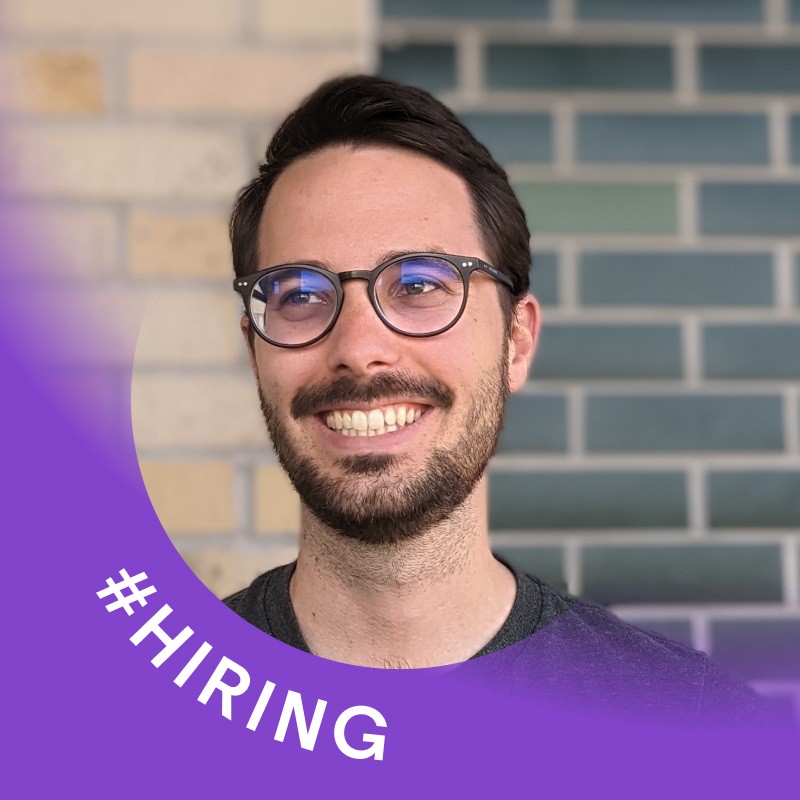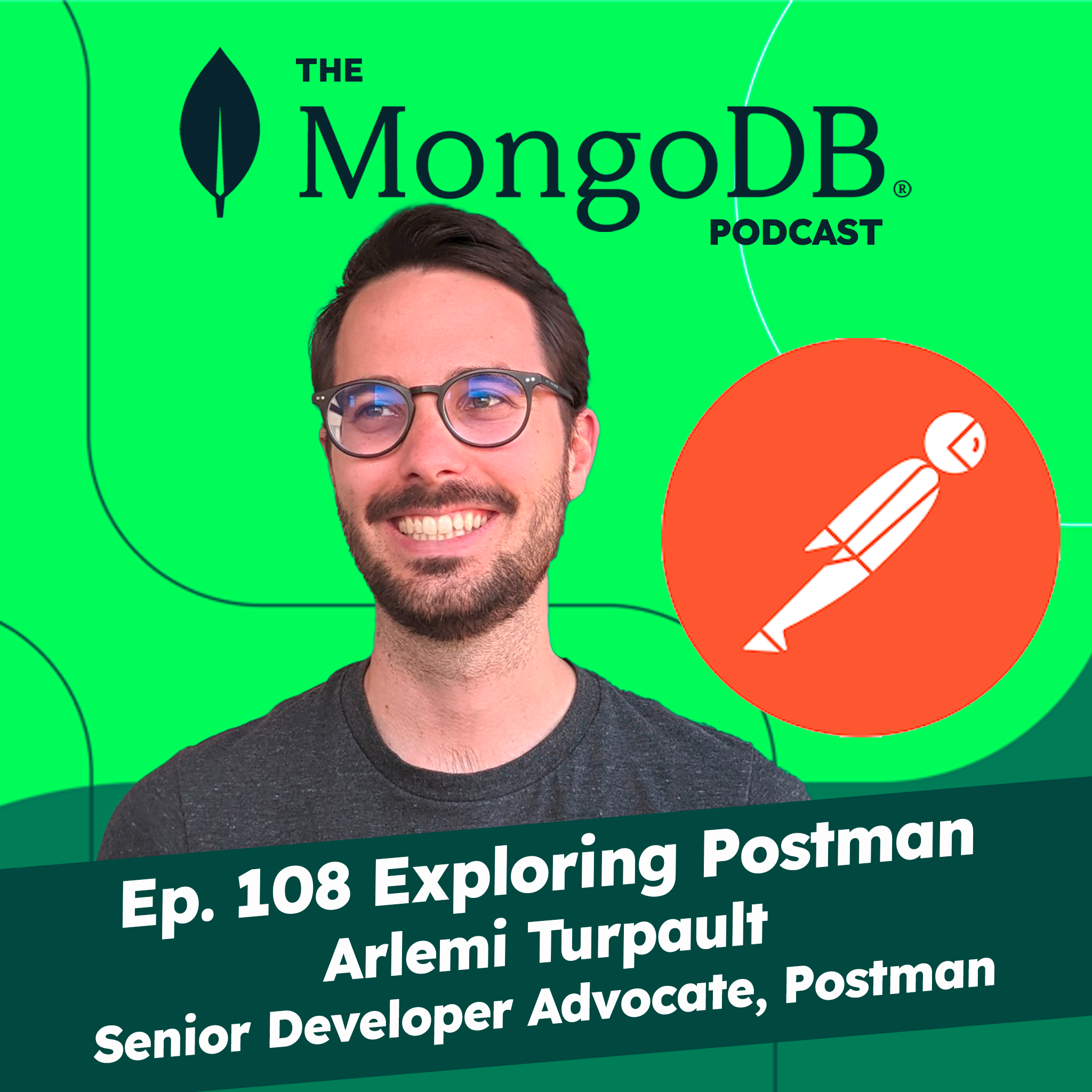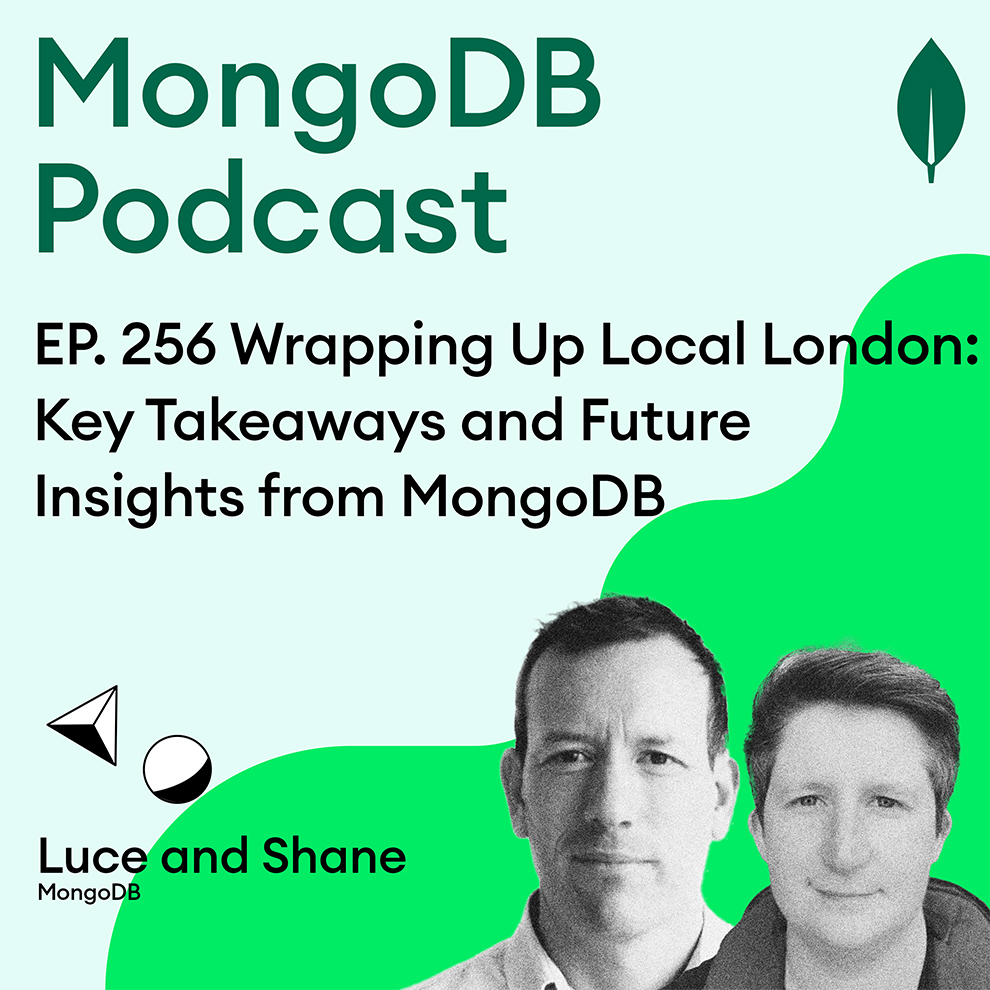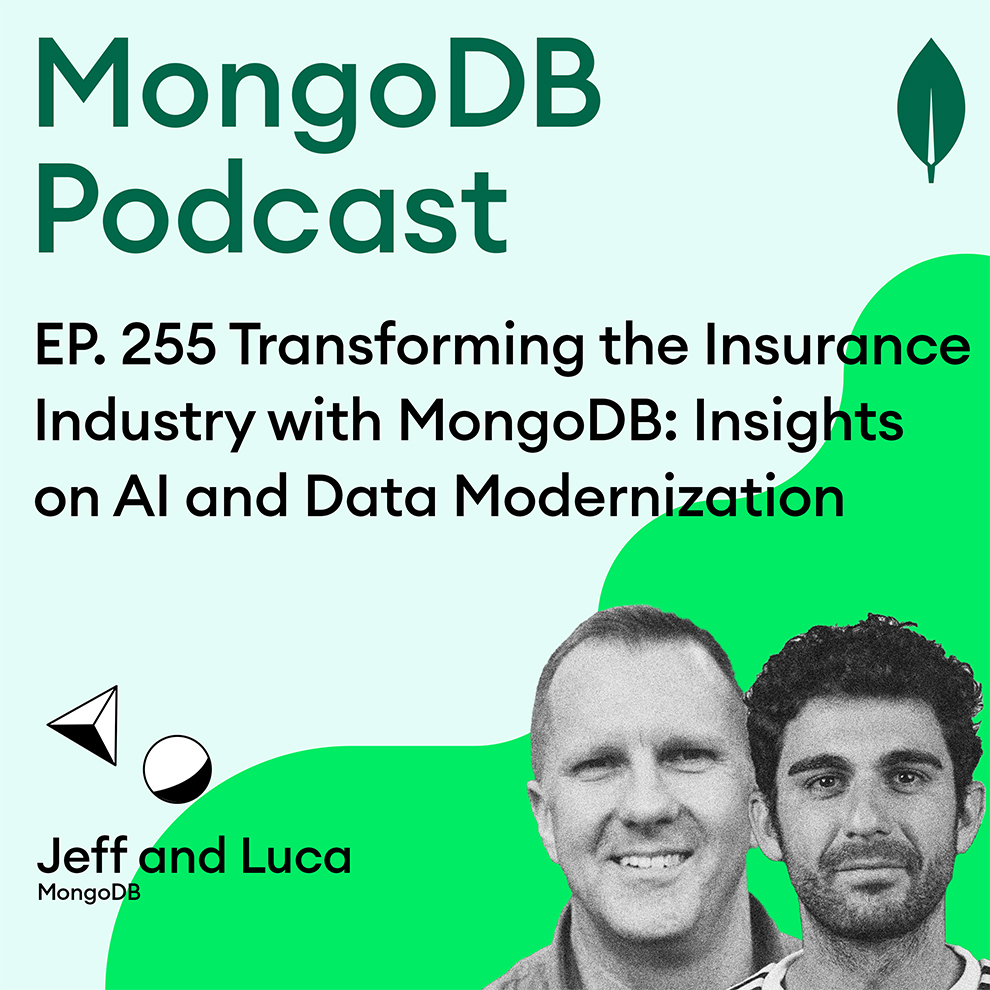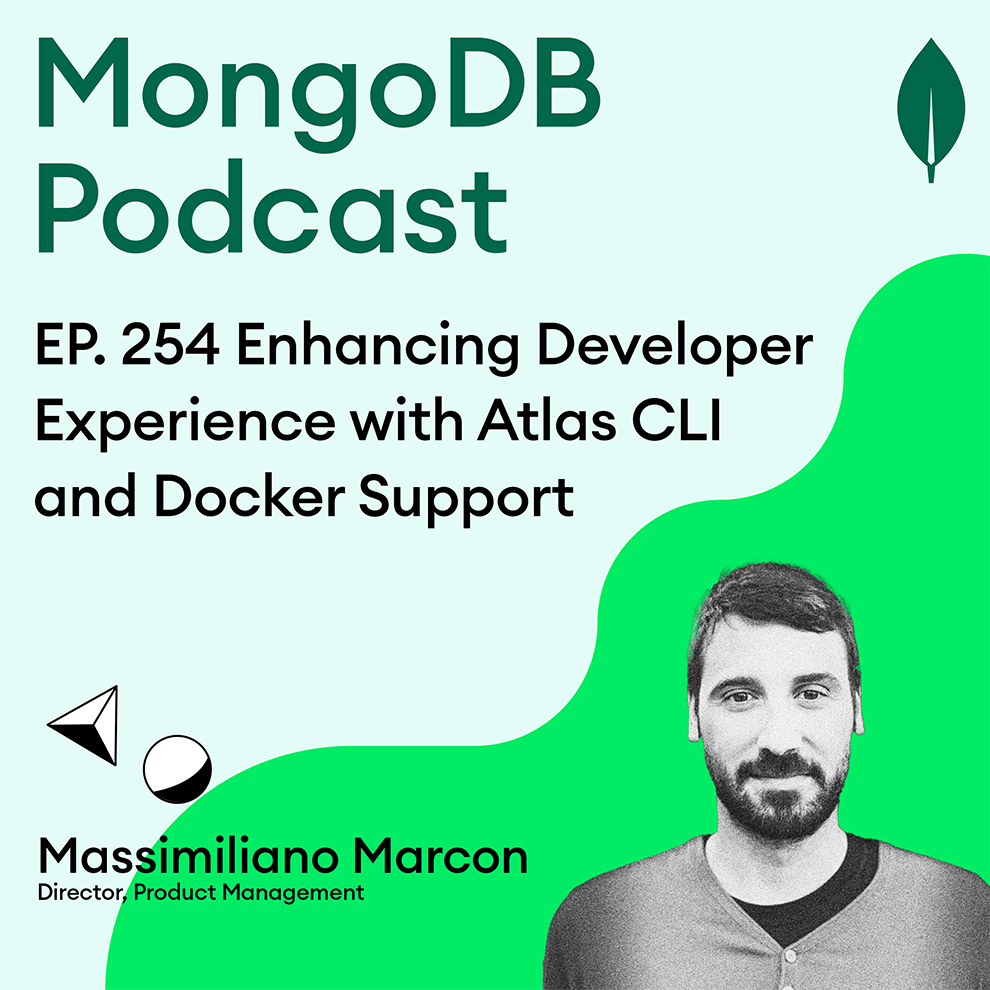Ep. 108 Exploring Postman with Arlemi Turpault
- 0.5
- 1
- 1.25
- 1.5
- 1.75
- 2
Arlemi Turpault: Hi, my name's Arlemi Turpault, I'm a senior developer advocate at Postman and welcome to the MongoDB podcast. A lot of people know Postman, but they might have known Postman three, four years ago, even seven years ago when it was a Chrome extension and it has changed a lot. Postman started as what we call the API testing tool. Short answer, Postman is the API platform caters to both API producers and API consumers.
Michael Lynn: Welcome to the show, today on the podcast, it's all about Postman. Postman used to be just a very simple API testing tool built right into Chrome, Chrome extension. It's expanded to so much more. It's a full platform. If you're a software developer and your software interacts with users or other systems, you're going to want to check this out. There's this concept of API- first and many companies are shifting to that mindset. Arlemi's going to talk all about that and tell us more about Postman, the Postman Platform. Stay tuned, this is the MongoDB podcast. Join us live in New York City, June 7th through the 9th for MongoDB World 2022. The future runs on MongoDB. There's going to be something for everyone at MongoDB World. It's a conference that was created by developers for developers, and whether you're learning the basics or you're ready to scale. You'll find sessions that are tailored to you. Join us as the database community comes together in New York City to create, disrupt and transform. Visit mongodb.com/ world- 2022 to register. Use the code podcast for 25% off tickets. We've got some really exciting things happening on Twitter coming up, you're going to want to follow me, Michael Lynn at M as in Michael, L- Y- N- N. That's @ MLynn, some interesting things happening on Twitter Spaces coming. It's going to allow you to listen, but also ask questions and interact. Follow MLynn for some upcoming interesting content. Welcome to the show, it's great to have you on the podcast. How are you doing today?
Arlemi Turpault: Doing well, doing well, and you?
Michael Lynn: Doing fantastic. Thank you so much for joining me today. Let's begin with an introduction, maybe you could tell the folks who you are and what you do.
Arlemi Turpault: Yeah, sure. Thank you for having me first. I'm a senior developer advocate at Postman, which is known now as the API Platform. I do a couple things here, part of our role is to grow the number of people that we have using the tool, obviously, but creating content, going to talk at conferences, whether they're virtual or in- person, and just making sure that whatever feedback we get from engaging with all type of users goes back throughout the product team as well. So there's this whole like two- way street that I like to talk about when I talk about developer advocacy. Talking about the product, but also being the voice within the company and for external users.
Michael Lynn: I love that. And that's a huge part of developer advocacy, very often left behind, very often people forget about that two- way street taking feedback back to the developers. I want to ask you about that before we get into the meat of the show. What does that look like for you bringing that feedback back to your developers?
Arlemi Turpault: There's different ways it's being done, because the company has grown a lot lately, when I started at Postman, we had one developer advocacy sitting in each of the squads, engineering squads that we had. We were there from the start when the product spec were being thought about, or whenever we were having a neighborhood put together some feedback and bring it in, not because of the scale of things, we want to make sure that we have some processes in place and feedback can come from wherever. We have some simple forms whenever we hear some feedback from a partner or any user, really just make sure that we can link it to other similar feedback that we've had. We can weigh the impact of it, how many people are asking for this type of stuff. And obviously we try to be as transparent as possible, so we have a GitHub repository where we track all feature requests and bugs as well. We tend to redirect people there as well to make sure that they add their feedback there. And we can have a look at it as a whole, when we try to fix that specific issue, or release that feature request.
Michael Lynn: I love the transparency, APIs are all about increasing the transparency of the work we do. So it makes perfect sense that Postman practices transparency in their workflow. So great, congratulations on that. Hey, I wanted to ask you about Postman, maybe explain to the listeners what Postman is?
Arlemi Turpault: Yeah, sure. If you don't mind I'm going to go back in time a bit, because a lot of people know Postman, but they might have known Postman three, four years ago, even seven years ago when it was a Chrome extension and it has changed a lot. Postman started as what we call the API testing tool. And the point was just, you have an API end point, but it in there, see what's coming back and then you can start documenting it and maybe chatting to other people on how you want to use that API. Then it grew into an API collaboration tool, several people working on that same API and trying to help each other or maybe sharing some API endpoints together. And now one thing that we've probably been focusing on for the last two years is turning it to a full- on API platform. When we think about an API platform, we have two sides to an API. There's the API consumer, which is what we've been doing for the last seven years, which is, I want to use an API, how do I do that? Postman how can it help me maybe generate cost snippets, maybe documenting my API? And then we have the API produce side. So anyone that creates API and that's some things that we've released in the last couple of years, supporting OpenAPI schema. API definitions in general, monitoring your APIs, integrating with tons of other tools like API getaways, et cetera. That was the long answer, short answer, Postman is the API platform caters to both API producers and API consumers at the moment.
Michael Lynn: Well, thanks for the detailed explanation and it's so helpful. My knowledge and experience of Postman is exactly like you said, I started using the Chrome extension and like we talked about with visibility, how wonderful it is to be able to take an API that I'm using, I'm consuming and use Postman to see exactly what's happening in that conversation. Can you tell me a little bit about the scale that Postman is at today? How many users of Postman are there?
Arlemi Turpault: We have at least 17 millions, probably more, 17 million was the last time we counted probably a year back. I think we announced that. This has grown since, but I don't have any public number. I just know it's more than 17 million, which is pretty good. And then you can imagine how many requests are being sent by this amount of users, et cetera, how many connections they create. That's a pretty big scale to work with, which makes my work just even more interesting.
Michael Lynn: It's massive scale. That's wonderful to see that many users of course. And you said, I can probably imagine how many requests are coming from that many users, but I don't think I can, 17 million users probably somebody's actively testing, they're sending hundreds of requests per day?
Arlemi Turpault: Yeah, probably have to think in billions.
Michael Lynn: Billions, yeah. It's probably a good estimate. For more information about Postman, if you're listening to this and you're interested, where do folks go right away?
Arlemi Turpault: The main one would be Postman. com. That's all homepage. You can now use the too in your browser, so you could get that straight away from that page. But you'd also find all the information on what we think APIs are going, what you can do with the Postman tool and then how it caters to the whole API life cycle. That would be the main place for people to go and check at what we're doing.
Michael Lynn: I've used Postman for many years on a free basis. I hope that's okay, number one. Number two, how do you make money? What's the revenue model for Postman?
Arlemi Turpault: Good question. It's very fine to use it for free, and that's what the tool is made for. One of our beliefs is that as a single developer, you shouldn't need to pay for Postman. The business model is mostly that once you get more into collaborating in Postman, et cetera, teams will be the ones who need to pay. So either because your team is more than three people. From four people, you might need to start paying and to upgrade to the basic plan. And the other reasons might be based on some type of enterprises feature that you might need. It can be reporting, it can be governance, it can be for example, having SSO enabled for your team. Only adding people with the mongodb. com domain being able to join your team, but also maybe them not being able to use any other team. Because you won't have that governance of what your users are doing. This type of features are the reasons why you might want to upgrade. But I've never used a paid Postman account before joining Postman either. And I was also a pretty heavy user, but as a single developer you shouldn't need to.
Michael Lynn: Well, I can see the value though. Definitely in the enterprise space. You've got a lot of folks that are working in teams collaborating and while doing work on my own on projects, it's not super important that I have a lot of metrics and a lot of reporting and analytics around the requests I'm making as a team, especially in the enterprise space. I can imagine that's super important. I'm wondering how is it doing in the enterprise space? Are you building a lot of customers in that space?
Arlemi Turpault: Yeah, I'm actually not sure which consumers I'm allowed to mention. I'm not going to say any big names, but we have tons of banks, for example, all types of industry in healthcare, in gaming as well. I know one we have a public use case about is, I think a big games. We have some big companies out there. And I think one of the thing you mentioned is, because of the scale and you might use it as a single developer. One of the thing is, you are coming from your single project on your side, you join a company and you are using Postman and you might start talking about it within your company. And it's very much a bottom up things that we've seen until now, obviously, because as we grow, we'll try to do, we have more like outreach to people as well, but so far this whole, oh, I'm using Postman, they start using it together and use it within our team. And maybe as a grows company, for example, Microsoft, we had several small teams using it. And then they started getting it at the company level, so it goes.
Michael Lynn: We're seeing this shift in the mindset of developers, especially more recently focusing on the API. I can't imagine beginning a project today without having the API in mind first, can you talk a little bit about that mindset and the shift that's happening? I mean, how pervasive is this, is just my take on things?
Arlemi Turpault: No, I think you're right on. And you had all the right words as well. You said API, you said first, that's the thing we believe in. It's being API- first and companies turning to API- first and you're not the only one thinking about that to have quotes from people from Etsy or Netflix, or I think even AWS joined fully API- first for most of their squads with, I think it was called the API Mandate. We have like big companies joined to that. And the belief behind it is the API is the thing that's going to allow everyone to use your app, and communicate between different squads and parts of your company, or different applications. Having that defined from the start is just going to make decouple the dependencies, it's going to make it much easier to scale. And having this single source of truth is also going to help in the long term. Having, I mentioned API definitions at the start, having this API definition that says exactly defines the requirements, defines and designs your API. From there, I can generate code, I could generate documentation, I could generate a mock server to my front end team so they can start building. And also I can do some contract testing. I give that to my consumers, they start testing it against that. They give me back the tests and then me as the producer, I run these tests as I go. And I make sure that I don't break anyone's workflow. That's something that people don't like when you break their workflow and having these API- first mindset of also helps with not breaking this. So pretty good.
Michael Lynn: Now, I mean, traditionally API, it's on the back end, but I'm seeing more and more focus on APIs from the mobile perspective as well. I mean, the importance of creating an API- First, I can't think of a better space than in the mobile development world as well. Are you seeing a lot more developers coming from the mobile space focusing on the APIs?
Arlemi Turpault: I feel like we see more businesses being built on top of an API, or just being on API. I wouldn't say we see more mobile... This is me personally, but that might just be because I'm not in that space, but one thing for sure is that yeah, before you would've businesses that are run on the API, but they have this front and they have to build their own store, or their own website on top. And that's the service they're going to sell. Now, you can see Twilio, or you can see Stripe and you can see all these type of companies that they're just going to have an API, and that's what you're going to build with. Whether you are frontend, backend, or mobile app developer, it doesn't really matter. And that's definitely one thing that we see and I think last year we looked at the Forbes 100, and we just looked at how many of them had a public API that was for people to use, and it was about 90% or 95%.
Michael Lynn: Wow. Wait, wait, wait, I don't want to gloss over that. I don't want to gloss over that though. But you said of the Forbes 100, 90% are API based, they have APIs available?
Arlemi Turpault: Yeah.
Michael Lynn: That's incredible. Well, we have a great partnership, Postman and MongoDB, we have seen this for some time. From the MongoDB Platform side, we realize that the API is absolutely critical. We've leaned in, we had an Atlas API early on, we created a new Data API. So that's available from within MongoDB Atlas that will expose access to methods that you would typically have to use a query, a driver to access. And these are available from an API now, and that's the MongoDB Atlas Data API. And I think when we scheduled this discussion, I didn't know about this, but what I just learned through a tweet that we've got some interesting things happening in the space between MongoDB Atlas and Postman. You want to talk a little bit about that?
Arlemi Turpault: I'm just going to jump quickly back on what you just said, MongoDB being a great example of a company that wasn't mostly like API driven, because database is you access them differently. But then definitely took that turn and made it also available. Obviously you're not changing, or turning away from anything else, but you're also adding that API capability on top. What we've done with we've MongoDB, I think we've been partnering for more than a year now, doing different things together. One of the things that the other team at MongoDB did was creating a Postman Public Workspace. On that public workspace, they've made a collection available, which is this MongoDB Atlas Data API that you can use. Anyone can come in for that collection start using it. But on top of that to just make it even easier for MongoDB users to use that collection. Within the MongoDB dashboard, you have this one click trade button for the API that you can click on, that also directly force the API, and then you have it in your workspace. Obviously you need to fit in your own API key and you need to maybe give the name of the cluster you want to use, the database you want to query, et cetera. But you have this list of, I think, eight to 10 endpoints that you can just use out- of- the- box.
Michael Lynn: And I want to disambiguate, we've got the term collection, which is used in different context in MongoDB. Obviously a collection is a collection of documents who are document oriented database. Explain what a collection is in Postman?
Arlemi Turpault: Good points. Collection in Postman is also a group of request in that case. In Postman, you can group... We have different type of collection at the moment, it could be a group of synchronous request, typically REST API, but you could have a web sockets specific collection, that's for your asynchronous web socket API, but typically a collection is a group of API requests, whatever the type of them they are.
Michael Lynn: It's a way to organize your projects and your requests that are similar in nature. And I guess, that's really the same concept in MongoDB, you're going to group your documents that are similar, not exact into a collection.
Arlemi Turpault: We see two main user agents from partners mostly. When they have their public workspace, they'll have a collection, which is the whole API reference. The list of all the endpoints that you can use, then they'll have workflow type collections. It's for example, a collection that tells you how do you create a user and assign it to a group let's say, and you only have a subset of the API reference, maybe four or five endpoints in that collection. And then as a user, you can just pull these specific set and start using it.
Michael Lynn: Getting a bit meta, Postman is an application, it's got a user interface. Is there an API to Postman?
Arlemi Turpault: There is very much an API, which to be honest, it's pretty hard to find, because when you Google Postman API, it's not the first thing that comes up. But if you're interested in that api.postman. com is the direct link to the documentation. But we have an API and Postman is actually a great of a company that was not API- first and is turning API- First. For the last couple years, we've been trying to turn our squads into being API- First, everything starts from an OpenAPI definition, and then they have contracts with all the other squads in the company to measure, we're not breaking any flows. We're not there yet, but nowadays I think every time something new is released, we have the equivalent that comes out in the Postman API directly. So you should be able to do pretty much as much as you do in the UI through the API.
Michael Lynn: Great. We talked about the test in Postman button that now appears in MongoDB Atlas. If you want to check that out, log into your Atlas account, click on the Data API link in the left hand navigation menu, and you'll need to create a Data API instance, link it up to a data source, and that'll give you the ability to create an API key. And then you'll see that button there. And that'll bring you over to Postman's web interface. I don't think it launches the app, right? I think it brings you to a tab and a browser that automatically logs you in and exposes you to, like you said, the public collection for MongoDB Data API testing, right?
Arlemi Turpault: Yep, that's it.
Michael Lynn: Terrific. Well, that's a great way to increase the visibility of MongoDB and the Atlas Data API. Seeing how these methods find update, delete that are exposed to via the MongoDB Atlas Data API, great way to increase the visibility of testing those. Great work. Do you want to talk a little bit about what's happening coming down the pike, what's next for Postman? Are there things that are exciting in the roadmap?
Arlemi Turpault: Let me again think of which one I can mention and which one I can't, but mostly for example, we talked about enterprises. One of the thing that we work on, and that's also a big driver for enterprise is to subscribe to Postman is integrations. Postman doesn't mean to replace API gateways. It doesn't mean to replace code repositories for example. Integrate with tons of other platforms like GitHub, GitLab, Azure repos, et cetera. One of the next focus is going to be API gateways. Azure APIs and AWS API Gateway, the Google RPG, et cetera. That's one of the things I'm very much looking forward, having these integrations in the tool. And then there's things a bit more fun to me, which are just playing with all types of requests. I mentioned we have webs sockets and we have REST APIs. We've just added GRPC. And one of our focus is we want to be able to cater to any type of API developer or user out there. So we'll definitely add more protocols in the coming year. The last thing I would say, which is pretty exciting, it's already available. Still in beta is Postman Flows. That's our low- code version of Postman, where you have these little boxes, you can just drag and drop them onto a canvas, link them together. And you can create a workflows of the API requests, chain together and create some creativities. Is limitless just based on which API you use, just link them together and then start your flow and you can see what happens.
Michael Lynn: Oh, that is interesting. I use some other tools for that. Will that be offered as a service, a standalone service?
Arlemi Turpault: It's part of the tool. If you open Postman on the left hand side, you have the different categories. You have collections environment monitors, and one of them is Flows. So you have this canvas in the tool, you can grab your request from the left hand side, drag and drop them on there and start doing some linking. Obviously we have also some other boxes to do some merging of API responses, maybe some filtering, some pretty cool stuff.
Michael Lynn: Great. I'm definitely going to check that out later today. Is there anything else you want to tell the audience? Anything else you want to let them know about Postman?
Arlemi Turpault: Couple more things. I've mentioned and you've also mentioned the API- first mindset. If you're interested in that learning more, we actually have a graphic novel that you can check online. If you just Google the API- first World, it's available on the website and you could just scroll through the pages to show one pretty approachable. I would mention as well that we're hiring. If anyone is looking for a job at the moment, a change of carrier, do check our platform. And then you're just willing to learn more about Postman, couple places, couple places you could check. We have the 30 days of Postman challenge, which is a coding challenge in Postman, one day, a challenge day, sorry, where you can just go through and learn more about Postman and then our YouTube channel. YouTube. com/ postman turns of learning materials. We do live streams, we do some webinars on there, but check it out.
Michael Lynn: Fantastic. Well, I'll link in the show notes, if you're on the go while you're listening to this, make sure you touchdown at some point, check the show notes and check out those resources. You're hiring, you've got a YouTube channel, you've got a graphic novel, what is that about?
Arlemi Turpault: I do want to make it clear, it's not product oriented at all. It's very much what we think the API- first mindset is going to lead us and how we think the world is going to turn API- First. And it's already slowly turning API-First, where everything is going to be an API. And you can think of any type of interface, whether it's a voice interface, whether it's audio, video, or it's a text interface, it's probably backed by an API somewhere. It's a quick book. I have a hard book cover here, but there's no videos. I'm not going to show you, but that's the story.
Michael Lynn: Once again, I'll mention that we'll link in the show notes all of the resources that we just mentioned. Arlemi, thank you so much for dropping by, appreciate it.
Arlemi Turpault: Thank you for having me.
Michael Lynn: Thanks so much to Arlemi for dropping by, telling us all about Postman. Check the show notes for links and resources. Make sure you follow me, Michael Lynn, that's @ MLynn on Twitter. Got some interesting things happening with Twitter Spaces coming up. It's going to allow you the opportunity to listen, but also engage, ask questions and interact with some other members of the MongoDB community. Follow @ MLynn on Twitter. Remember MongoDB World is returning to New York City, it's June 7th through the 9th. Make sure you visit mongodb. com/ world- 2022. Register with the code podcast for 25% off tickets. Thanks everybody, have a great day.
DESCRIPTION
Postman is not just for API testing any longer. While it started as a Google Chrome Extension primarily used by developers for API testing, the platform has grown and is being used by more than 17 million developers worldwide to build, test and document their API-first initiatives. MongoDB and Postman have partnered to integrate Postman into the MongoDB Atlas Data API with a "test in Postman" button.
Check out Postman:
- https://www.postman.com/
- https://twitter.com/getpostman
- https://www.linkedin.com/company/postman-platform/
Read about API-First:
30 Days of Coding Challenge:
Connect with Arlemi:
Read About MongoDB Atlas Data API and Postman:
Today's Host

Shane McAllister
Today's Guests
